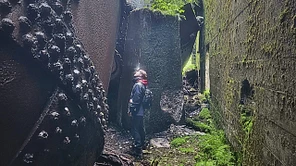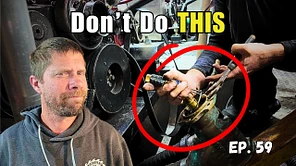Introduction
I have lived off-grid on my boat for over 3 years now with my family of 4 — now 3 (our son moved onto land) and the biggest thing we had to figure out to live on board full time is WATER! Where were we going to get water? Especially since we were not on a dock and instead on a mooring or cruising the waters of the Pacific Northwest.
>>SUBSCRIBE TO OUR YOUTUBE CHANNEL
Traditional Methods of Acquiring Fresh Water
It use to be that you could only get water in marinas or by hauling jugs of water into your dinghy from taps on land. However this has been getting harder and harder to do in North America as many marinas do not like liveaboards or allow liveaboards to dock for a few hours to fill up with water. Many marinas are now charging day rates for people to do this.
Public docks also do not have water and in Canada, where we live, the water sources on land are turned off in the winter to prevent the pipes from freezing.
Many places allegedly have public water spiggots but I haven’t been able to find one around Victoria BC. This means filling up from house spiggots and it’s very awkward to ask permmission to do so.
Gas Stations do have spiggots however then there is the issued to transporting your jugs of water.
The other way of getting water is to purchase — but for showers and washing dishes — this can get expensive.
Innovative Ways to Produce Fresh Water
1. Reverse Osmosis
So we had to become innovative. How were we going to get enough water to run a family household? The only way we were going to be able to continue to live off-grid is to make our own water. Yep — we had to make the salt water that was all around us into fresh water.
Luckily — we had a reverse osmosis watermaker on our boat when we purchased it and my husband just had to fix it. Now the saltwater goes through 8 filters and one special one before it goes into our tanks — which we drink out of. The special one is a filter that puts the minerals our body needs back into the water. When you use reverse osmosis — the filters take EVERYTHING out of the water which includes minerals and if you drank this water long enough — you would develop health issues.
There are three other ways to make or gather water when living off-grid.
2. Rainwater Harvesting Systems
I worked in Bermuda for three years and the Bermudians have this down to an art. Their rooves are made to collect rainwater and divet it into large cisterns. You can do the same thing on boats. Your deck is a perfect collection surface — if you keep it clean — and the rainwater can be diverted straight into your tanks or through a filter system before it goes into your tanks. Your awnings and solar panels can also collect rainwater ans speaking from experience — washing your hair with rainwater makes it really really soft!
3. Solar Stills
A solar still works by using sunlight, which passes through a glass cover on top of the still, to warm up salty or impure water that’s placed in a container inside it.
As the sunlight heats the water, some of it turns into vapor or steam, leaving the salt and impurities behind. (think of a kettle)
This steam then touches the cool underside of the glass cover and turns back into liquid water, which is now pure. The glass helps by not only letting sunlight in but also by cooling down due to the outside air, which helps the steam turn back into water more efficiently.
This process gives us clean drinking water from salty or dirty water, using just the power of the sun. It’s a smart and eco-friendly way to make fresh water, especially in places where fresh water is hard to come by.
4. Portable Desalination Devices:
My sister has one of these on her boat it works like a humdinger. She has the Rainman system and when they are cruising and running out of water, she pulls out the case — hooks it up — puts the briny water drain overboard and the fresh water drain in her tank and turns it on. It doesn’t take long before all her water tanks are full and she can drink straight out of her water tanks.
However the Rainman is thousands of dollars. If you are looking for a portable desalination device — check out this one for under $200 from Amazon!
>>My Waterclub Reverse Osmosis System from Amazon
Ensuring Water Safety and Quality
Before you put water in your tanks — we highly recommend testing it to make sure it is clean and safe because once on the boat — it can contaminate your tanks and the cleaning process can be arduous.
>>BUY A DIGITAL WATER TESTER FROM AMAZON
Conclusion
Living on a boat is a dream for many but you have to remember that there are things you have to consider like where are you going to get or how are you going to make water.
I hope you enjoyed this blog and please check out our website for more interesting articles about life on a boat. You can also subscribe to our free monthly newsletter on our website.
Just a heads up: I may share posts that contain affiliate links. There is no extra cost for you however I do make a small fee for researching and recommending the product. While I strive to provide valuable resources and recommendations, please remember to do your own research before making any purchases. Your trust means everything to me!













